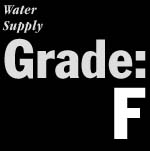 |
Home | Issues & Actions | About |
Archive Page This page is available as an archive to previous versions of LandWatch websites. |
LandWatch
State of Monterey County Report 1999
3.6
Water Supply
The major population areas of Monterey County have seriously insufficient water supplies. In the early 1990s, population growth on the Monterey Peninsula surpassed the number of people who can be served under Cal-Am's production limits. The Salinas Valley Ground Water basin is overdrafted by 40,000-50,000 acre-feet per year, and in North Monterey County annual extractions exceed average annual recharge by 100%. There are no approved or funded projects fully to address these problems.(12) Monterey Peninsula Another proposed project affecting water supply on the Monterey Peninsula is the Seaside Basin Injection/Recovery Project. This project entails diverting excess winter flows from the Carmel River through existing California-American Water Company (Cal-Am) facilities and injecting water into the Seaside Coastal groundwater basin for later recovery.(13) Salinas Valley Using reclaimed water from the Monterey Regional Water Pollution Control Agency treatment plant in the Castroville area for irrigation of crops will slow, but not stop, continued intrusion. There are no approved plans fully to resolve the problem. However, environmental review of a large-scale project is currently underway. The proposed Salinas Valley Water Project would include spillway modifications at Nacimiento Dam, reoperation of the Nacimiento and San Antonio Reservoirs, storage and subsequent delivery of available flows from the Monterey County Water Recycling Projects treatment plant to agricultural customers, and implementation of a proposed Nitrate Management Program. The subsequent phases of the project would include downstream diversion of water from the Salinas River as a result of reservoir reoperation, storage and delivery of diverted water, water treatment (as needed), and delivery area pumping restrictions.(13) North Monterey County In response to this problem, the Monterey County Water Resources Agency has initiated the North Monterey County Water Issues Action Plan. The Action Plan details various projects and policies to mediate the seawater intrusion and overdraft problems. In September 1998, county staff recommended a policy to the Board of Supervisors that would allow the transfer of water credits and water rights from non-contiguous agricultural lands to allow for subdivision of parcels for urban level development. After extended public hearings in which LandWatch and other interested parties vigorously participated, the Board of Supervisors requested County Counsel to develop an ordinance that would prohibit the transfer of water credits and water rights for subdivisions. While preparation of the ordinance has been approved by the Board of Supervisors, it has not yet actually been adopted. It now proceeds through environmental review, as required by the California Environmental Quality Act. Marina Coast Water District
|
|
CONTACT 306 Capitol Street #101 PO Box 1876 Phone (831) 759-2824 Fax (831) 759-2825 |
|
